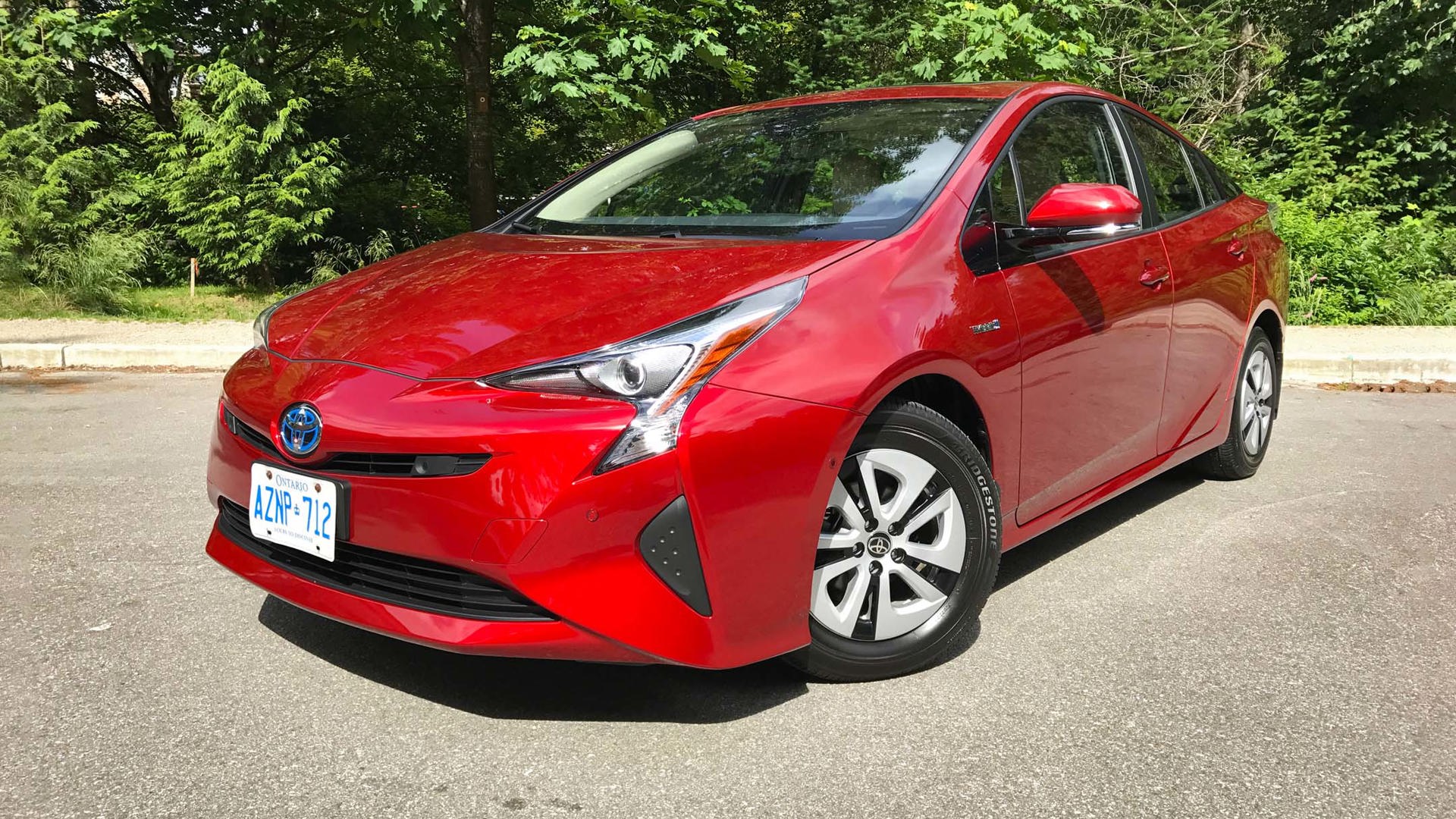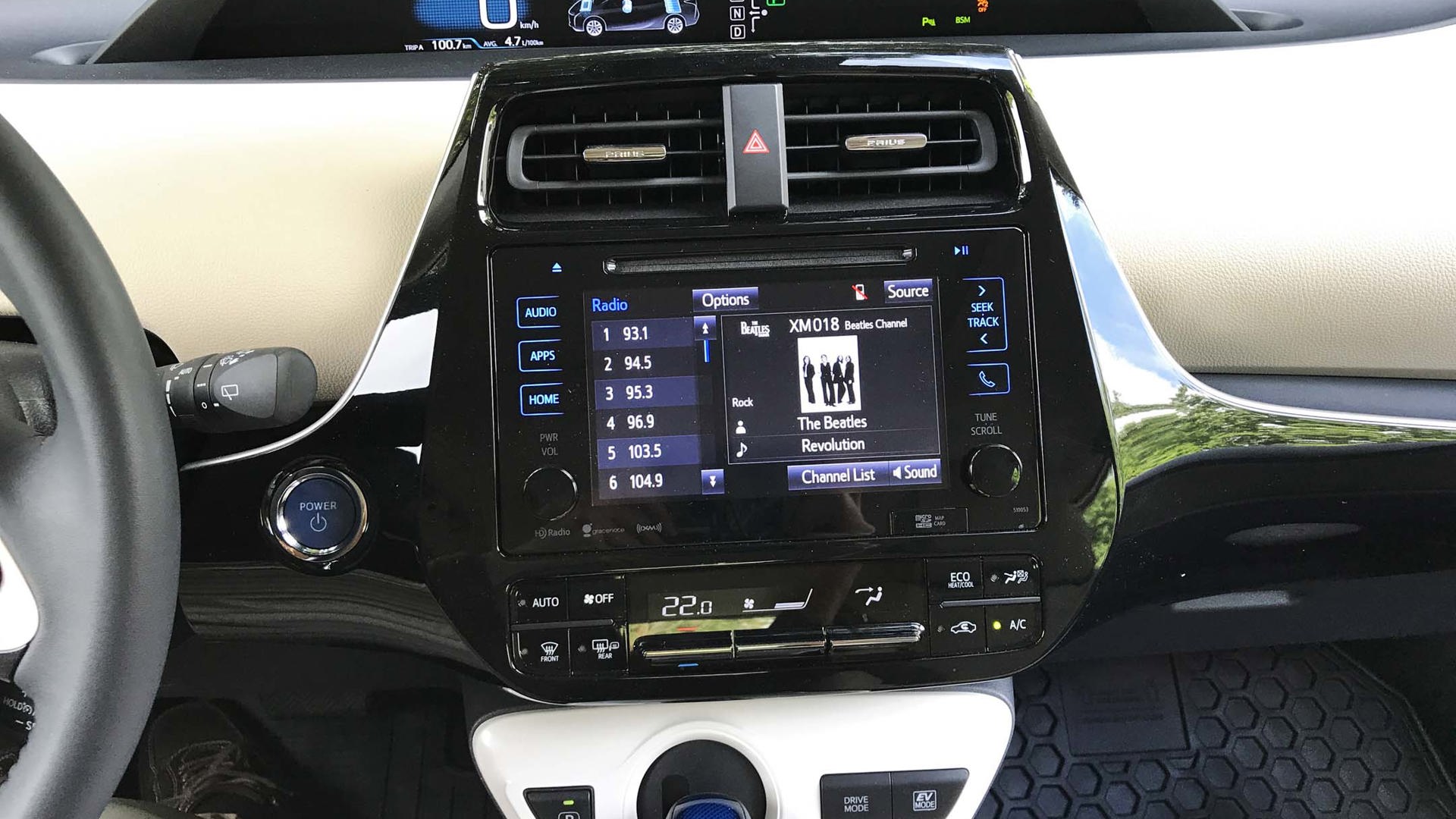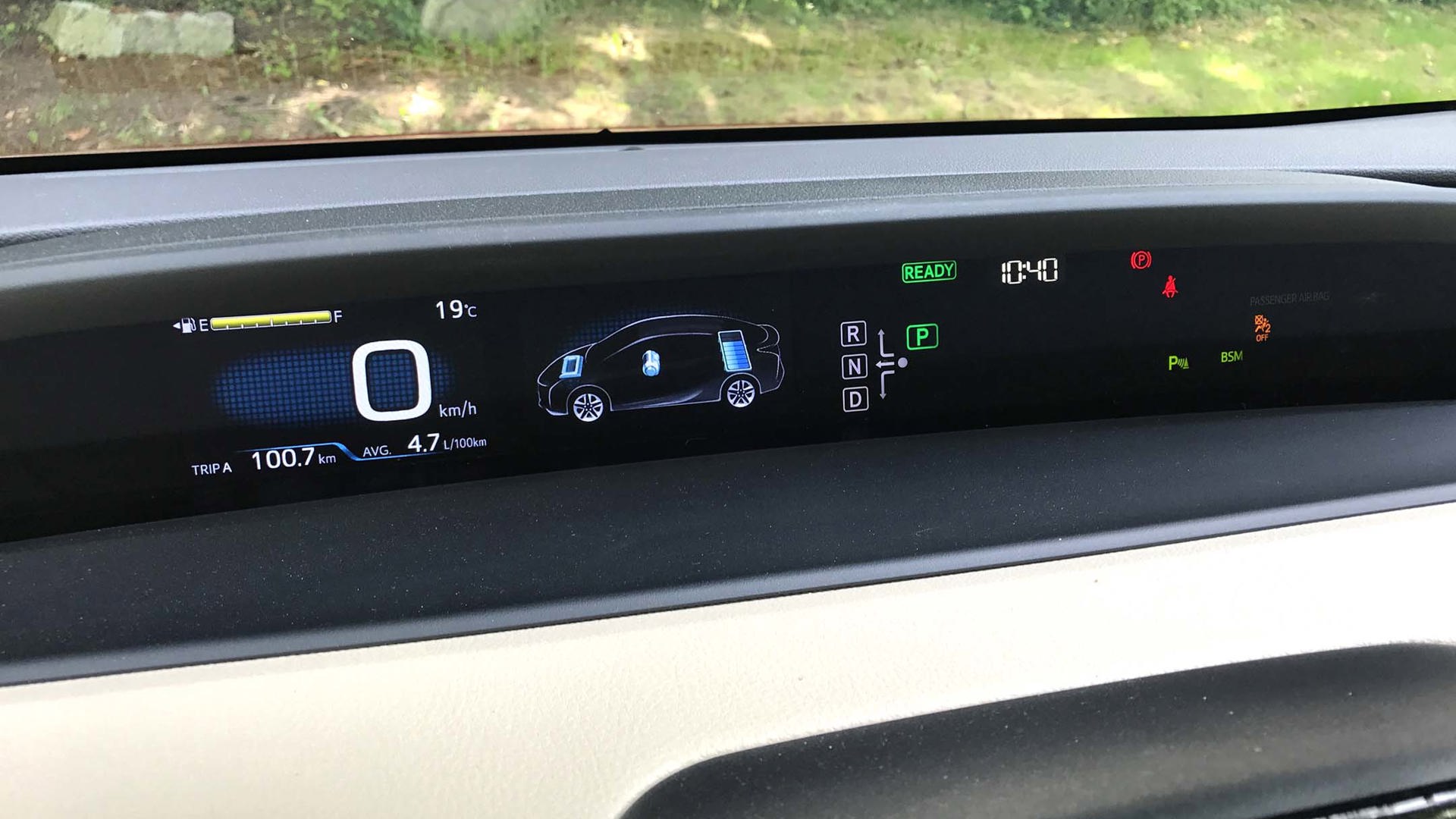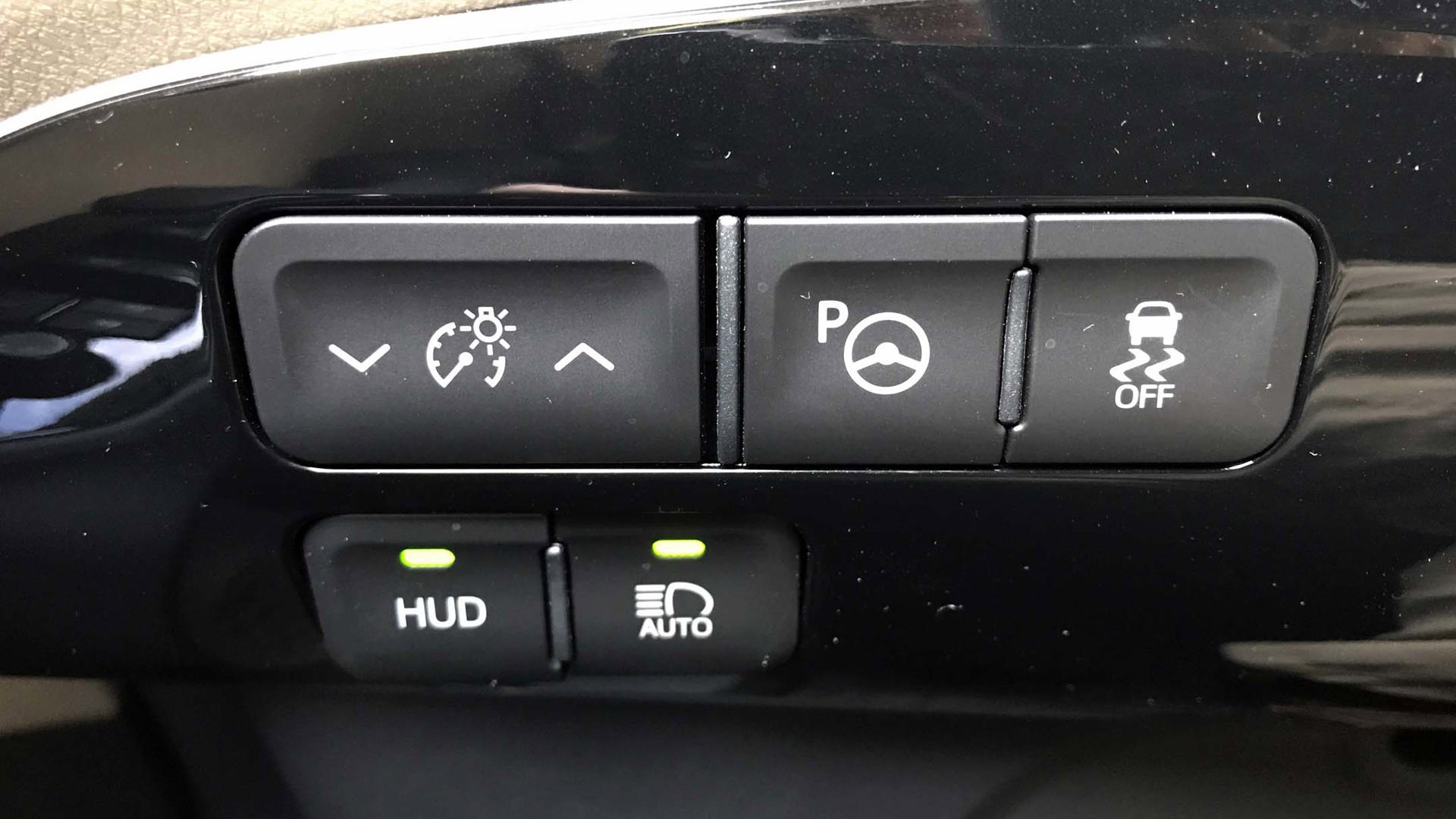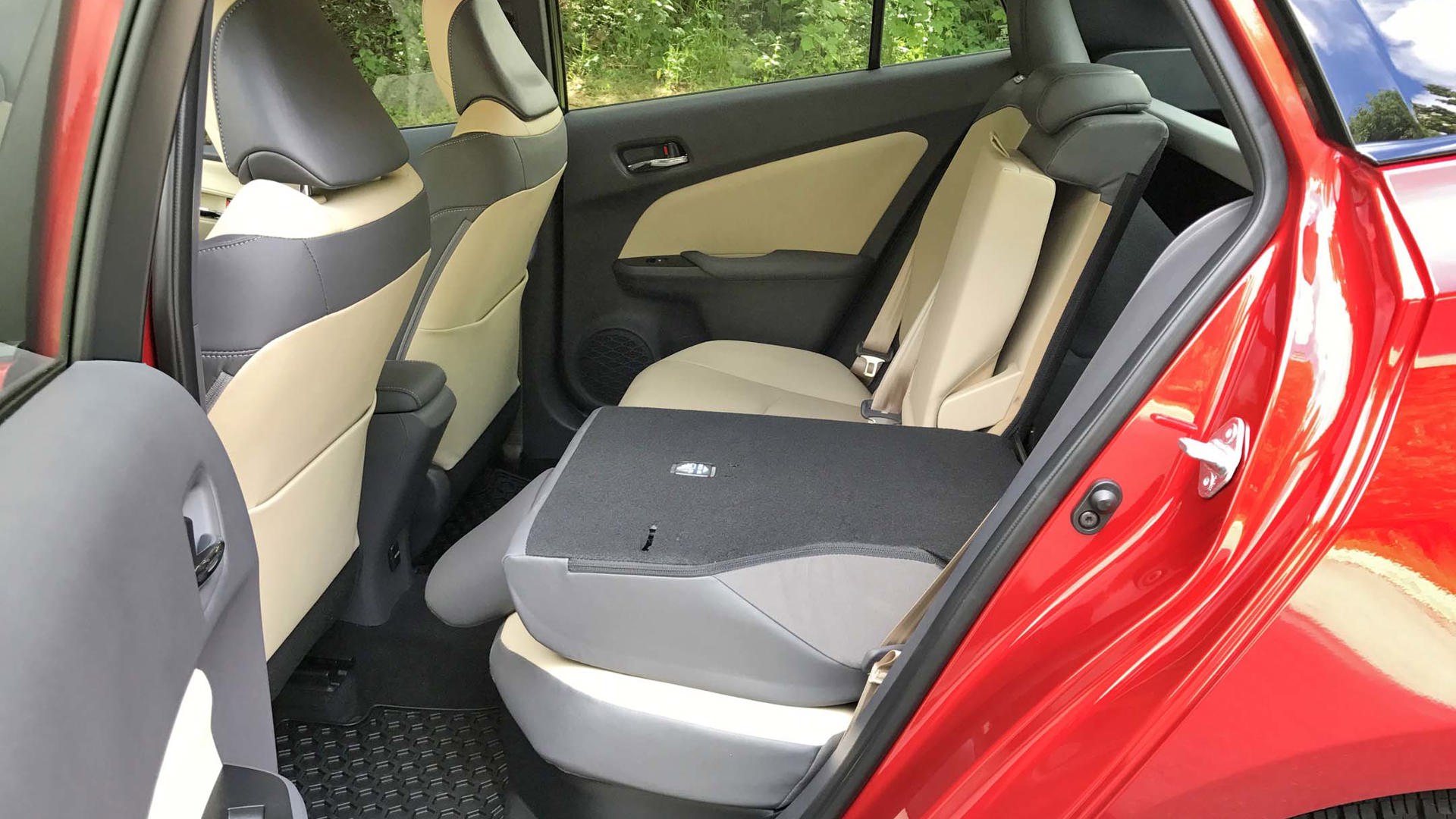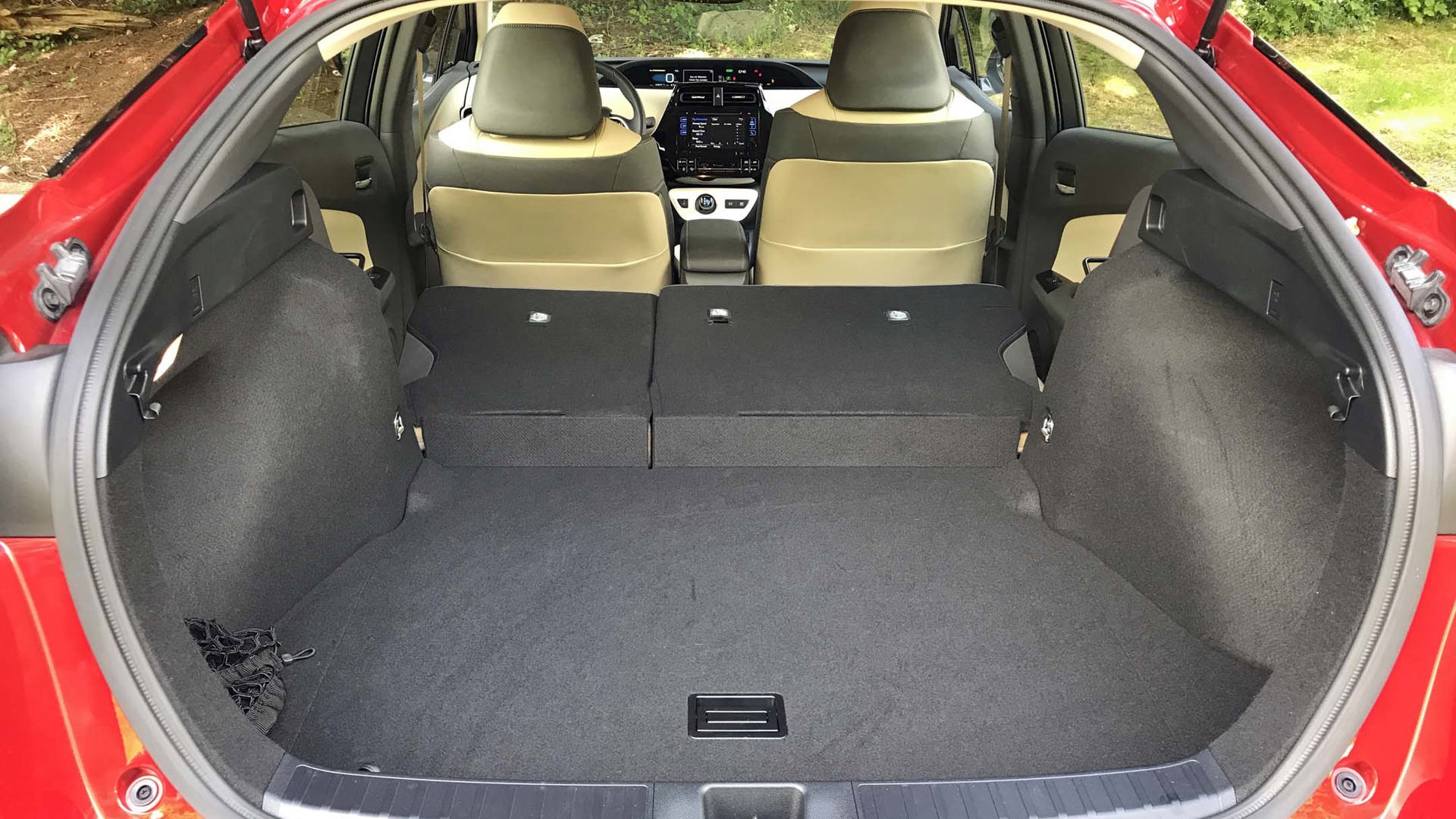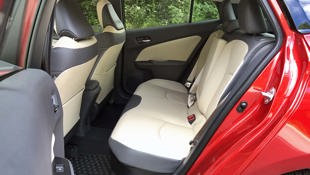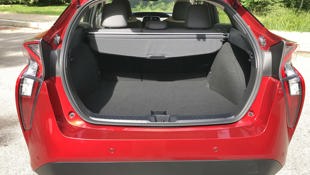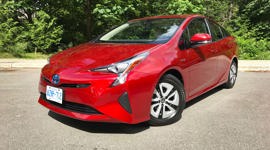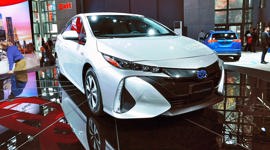 AutoTrader SCORE
AutoTrader SCORE
-
STYLING5/10
-
Safety7/10
-
PRACTICALITY8/10
-
USER-FRIENDLINESS7/10
-
FEATURES8/10
-
POWER7/10
-
COMFORT7/10
-
DRIVING FEEL7/10
-
FUEL ECONOMY9/10
-
VALUE8/10
Totally redesigned for 2016, the Toyota Prius hatchback returns for 2017 basically unchanged except for some added standard equipment and a small price hike to match. Toyota’s “Safety Sense P” group of safety features and heated front seats are now standard in the base Prius trim raising the price from $25,995 to $27,190. As well, the price of the Prius Technology trim has risen from $28,730 to $29,825 while the Prius Touring trim is up from $29,330 to $30,425.
The pre-collision and pedestrian detection system is the one you’ll appreciate the most that one time when a pedestrian walks out in front of you just as you reach over to adjust the radio.
The fourth-generation Prius has received plenty of positive comments for its improved ride, handling, and drivability – and mixed reactions to its more expressive styling – but what excited me the most about our 2017 Prius Technology test car was its fantastic fuel economy. After driving it for a week in a 50/50 mix of freeway and city driving with the air-conditioning on all of the time and without attempting any tricky hypermiling techniques or using the extra regenerative capabilities of the transmission’s B mode, I was able to average just 4.1 L/100 km. In urban areas where I did less freeway driving, I found that I could average close to 3.6 L/100 km.
Wow! For a five-passenger almost-mid-sized (non-plug-in) hybrid sedan that weighs 1,375 kg, these fuel consumption numbers are impressive. My real-world fuel economy results were even better than the official NRCan combined fuel economy rating of 4.5 L/100 km.
Admittedly, my test drive took place during balmy summer weather where temperatures were almost perfect for the hybrid battery. And I tried not to drive over 100 km/h on the freeway to conserve energy. As well, I pussy-footed it around town by accelerating gently away from stoplights and driving as smoothly as possible. But these are driving techniques anybody can use on a regular basis.
What, you may ask, do you have to give up to get these great fuel economy numbers? As before, there are compromises in drivability related to the Prius’ hybrid drivetrain.
For starters, the 2017 Prius is not particularly powerful. In fact, it’s less powerful than the previous-generation 2015 Prius. Its 90 hp 1.8-litre four-cylinder Atkinson-cycle engine and 60 kW electric motor produce a combined 121 horsepower (compared to 134). You can expect a zero to 100 km/h time of about 10 seconds. But like the previous-generation Prius, the new Prius has four driver-selectable driving modes – Normal, Power, Eco, and EV – that allow the driver to choose their own blend of performance and fuel economy.
Most of the time, I left it in Normal mode because I found that it offered the best combination of performance and fuel economy, but drivers who want quicker acceleration off the line can opt for the Power mode while those who want maximum fuel economy and who are prepared to sacrifice some acceleration and air-conditioning performance can switch to the Eco mode. Even so, when you put your right foot down hard in Eco mode, the Prius takes off in a real hurry – it’s not like it’s underpowered.
Without any noticeable gear changes, the standard continuously variable transmission allows the engine to rev continuously until the Prius reaches the required speed, but it’s quieter and grippier than I remember previous CVTs – so less noticeable. With very little engine or wind noise, the main offender is tire noise at freeway speeds which varies depending on the coarseness of the road surface. Around town, the Prius’ cabin is very quiet most of the time.
As part of Toyota’s Hybrid Synergy Drive system, the engine starts and stops automatically by itself while driving and while paused at traffic lights. This used to be jerky in older Priuses but in the 2017 Prius, there is little or no jerkiness. Sometimes you can hear it start, but you can barely feel it.
As before, by pressing the EV button on the dash, the driver can operate in electric-only mode for about one or two kilometres if the battery is well charged. But it is limited: when I tried using EV mode in a flat, urban area, I found that it would deactivate automatically if I accelerated too quickly or went over 30 km/h (I got a visual warning of “excessive speed”). EV mode is most useful in slow, bumper-to-bumper traffic to avoid having the engine stop and start, but don’t expect to be running for any length of time on battery power alone.
It should be noted that base Prius models have a carryover nickel–metal hydride battery but in 2016, the Prius Technology and Prius Touring trims were upgraded to a lithium-ion battery which is considerably lighter.
A noticeable improvement over the former 2015 Prius is its improved ride and handling: while previous Prius’ have a reputation for being boring to drive, this new Prius is definitely sportier. The fourth-generation Prius is longer, lower, and wider than the last generation, with a new high-strength steel platform that provides 60 percent greater torsional rigidity, a repositioned hybrid battery for better weight distribution, and a new independent double-wishbone rear suspension replacing the previous semi-independent torsion-beam setup.
To put it to the test, I drove it on the bumpiest, curviest paved road I could find in my neighbourhood. Now that the rear suspension allows the rear wheels to operate independently, the 2017 Prius corners flatter with more stability, and offers improved steering control and a more comfortable ride over undulations and rough surfaces. Pushing the car to its limit through some tight corners, the Prius leans a bit with some understeer, but it doesn’t get out of shape. Its main limitation is a lack of grip from the standard Bridgestone Ecopia 195/65R15 all-season tires. These narrow 15-inch tires are standard on the base Prius and Prius Technology trims while the Prius Touring trim offers beefier 215/45R17 tires. The 17-inch tires would be my choice, but they aren’t available on the base and Technology trims. Perhaps you can cut a deal with the salesperson!
Around town, I appreciated the Prius’ tight 10.4 metre turning circle. U-turns are a snap and it’s amazing how much this adds to your perception of the car’s manoeuvrability.
When in Reverse gear, there are annoying back-up warning tones inside the car. The horizontally split rear window does provide a clearer view of the area directly behind the car, but I found that the wide-angle rear-view camera with coloured guidelines provided the best view of the rear. In the Technology model with the optional Advanced Package there are also front and rear parking sensors that beep more frequently the closer the car gets to a solid obstacle.
My Prius Technology model was also equipped with the automatic parallel parking feature. It works like this: the driver presses a “P” button on the left dash while approaching a potential parking spot. Using external sensors, the Prius estimates whether the spot is long enough for the car. If it is, visual instructions in the screen ask the driver to stop just in front of it and put the transmission in Reverse. Then, the driver releases hands from the steering wheel and allows the car to creep backwards as the car steers itself into the parking space. After moving into the parking spot, the car instructs the driver to put the car in Drive and move forwards closer to the car in front. A warning message tells when to stop and put the car in Park. The automatic parking system works well as long as the driver follows the instructions about when to stop, when to Reverse, etc. Though it may seem intimidating at first, the automatic parking feature becomes second nature after you try it a few times.
All Toyotas come with the Star Safety System which includes Smart Stop Technology (car will brake automatically if accelerator and brake are pressed at the same time), vehicle stability control, anti-lock brakes, traction control, electronic brake force distribution, and brake assist.
New for 2017, all Prius models come with Toyota’s “Safety Sense P” as standard equipment, which includes a pre-collision system with pedestrian detection (in-car camera and radar sensors detect cars or pedestrians in front of the Prius and issues visual and audible warnings; if the driver doesn’t brake, the car brakes automatically), lane-departure alert (with visual and audible warnings), automatic high-beams and dynamic radar cruise. Of these, the pre-collision and pedestrian detection system is the one you’ll appreciate the most that one time when a pedestrian walks out in front of you just as you reach over to adjust the radio.
Only the Prius Technology model offers the optional Advanced Package ($2,675), which includes a blind-spot monitor with rear cross-traffic alert, Intelligent Clearance Sonar (front and rear parking sensors), and Intelligent Parking Assist (automatic parallel parking). This Advanced Package also includes “Softex” vinyl upholstery, heated front seats, eight-way power driver’s seat with power lumbar, head-up display, rain-sensing wipers, side laminated glass, garage door opener, auto-dimming rear-view mirror, and a tire repair kit instead of a temporary spare tire.
It seems odd that the additional safety features in the Advanced Package are not available on the base or top-line Prius Touring models, even as options.
Getting in and out of the new Prius is a snap: all four doors and the rear hatch can be unlocked or locked remotely or by simply touching the handle while having the key in your pocket. Once inside, a push-button starts the car. Bottom line: you don’t have to take the key out of your pocket.
The 2017 Prius cabin seems a bit bigger than the last-generation car, but it’s actually slightly smaller mostly because of the lower roof. It’s still roomy though, and both front and rear occupants have plenty of legroom. Front headroom is generous but due to the Prius’ sloping roofline, taller passengers in the rear may find their hair brushing the ceiling. As well, the rising window line creates the feeling of sitting in a hole.
Base and Technology models have standard fabric seats but the Technology model is available with optional “Softex” upholstery, an artificial leather. Top-of-the-line Touring models have standard Softex upholstery. In the Technology model with the Advanced Package, I appreciated the optional eight-way power driver’s seat and power lumbar adjuster, but these features are not available on the Base and Touring trims.
My Prius Technology test car had a two-tone black-and-cream interior with cream-coloured seats and dash materials. Though it looks attractive, I found the reflection off the cream-coloured dash too bright and I would have preferred a darker dash colour. A darker monotone interior colour scheme is available.
With the steering wheel mounted relatively low and the digital instruments positioned in the centre dashtop, the Prius driver has a unique view over the hood. The driver has to turn their head slightly to read the large digital speedometer readout in the centre, but there is an optional head-up display available that projects the speed and other information onto the windshield directly ahead of the driver. I find HUDs distracting, so I disabled it by pressing the relevant button on the dash.
The transmission shift lever is positioned low on the centre instrument panel with Reverse, Neutral and Drive in a vertical layout and B (like Drive but with more regenerative braking) over to the right side. Park is a button to the left of the shift lever. You can tell what gear you’re in by viewing the illuminated transmission selection display in the dashtop screen.
The bright dashtop screen also has a vehicle graphic that displays a real-time view of the hybrid drivetrain operation. Because you can tell when the gas engine is running or not running, it provides a real-time picture of your driving behaviour and an incentive to tread lightly on the gas pedal.
In this screen, you can also toggle to a view of the HVAC ventilation system, a menu for vehicle settings such as turning the lane-departure warning on or off, and a display of Power, Normal, or Eco drive modes. This is done with buttons on the steering wheel.
In the centre of the instrument panel, base Prius models have a 6.1-inch touchscreen with standard AM/FM/XM satellite radio, Eco Drive monitor, rearview camera, and Bluetooth wireless phone and audio. Prius Technology and Touring models have a 7-inch touchscreen with all those things plus text-to-voice capability, standard navigation, and a wireless cell phone charger on the lower console.
The 7-inch touchscreen features a home screen with Audio, Phone, and Navigation sub-screens. There is also a full-screen display for Audio, Navigation, Phone, Apps, and Eco functions such as a real-time hybrid drivetrain display and Fuel Economy history with best and average fuel consumption figures. Voice activation is available for phone, audio, and navigation.
Automatic climate control with air conditioning is standard in the 2017 Prius, operated via a button on the dash; you can choose Driver Only ventilation, or Front Passengers Only, as a way of reducing the power draw from the battery.
The Prius Technology and Touring trims come with a wireless smartphone charger on the lower console which is very handy if you have a phone that is compatible with Qi wireless charging. Unfortunately, Apple iPhones don’t have this functionality built-in and require a separate Qi charging adapter to take advantage of this feature. However, many popular phones such as the Samsung Galaxy or Google Nexus are compatible.
Cargo space behind the rear seats is a generous 697 litres but because the Prius Technology has a tire-inflation kit instead of a spare tire, its total rear cargo space rises to 776 litres. With the split-folding rear seats folded down there’s plenty of room for longer items. A removable, sliding privacy cover hides the contents of the trunk from prying eyes.
The rear hatch lifts up for easy access to the cargo area, but I found that it rises up so high that the rear spoiler can strike low roofs typically found in some underground mall and condominium parking lots. Watch out for paint chips!
The 2017 Toyota Prius hatchback is built in Aichi, Japan.
| Engine Displacement | 1.8L |
|---|---|
| Engine Cylinders | I4 |
| Peak Horsepower | 121 hp |
| Peak Torque | 105 lb-ft |
| Fuel Economy | 4.4/4.6/4.5 L/100 km city/hwy/cmb |
| Cargo Space | 776 L |
| Model Tested | 2017 Toyota Prius Technology |
| Base Price | $29,825 |
| A/C Tax | $100 |
| Destination Fee | $1,690 |
| Price as Tested | $34,545 |
|
Optional Equipment
$2,930 – Advanced Package (Softex seats, heated front seats, eight-way power driver’s seat with power lumbar, head-up display, rain-sensing wipers, auto-dimming rear-view mirror, blind-spot monitor with RCTA, rear parking sensors, parking assist, tire repair kit, laminated side glass) $2,675; Hypersonic Red premium paint $255
|
|
